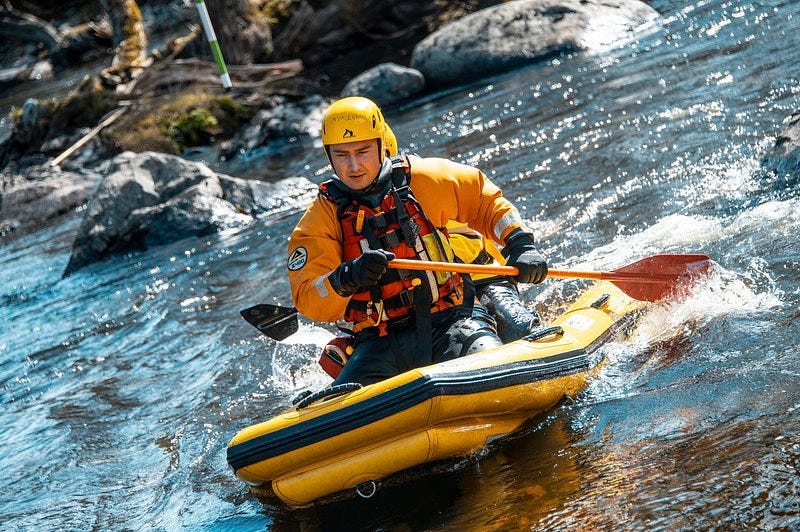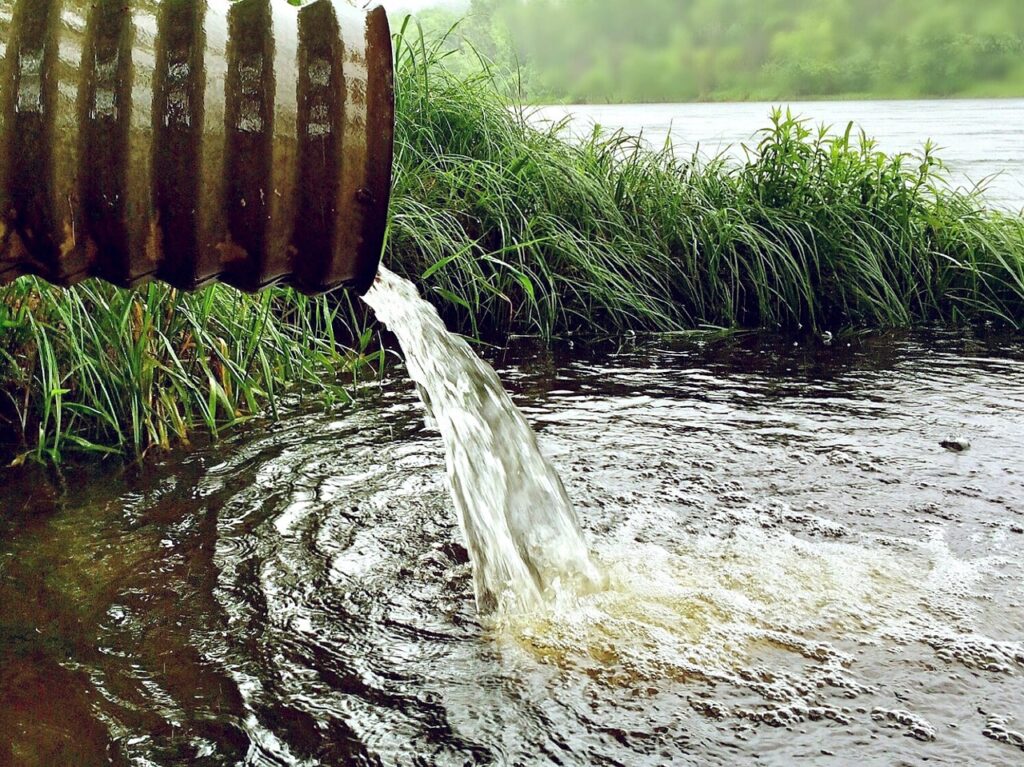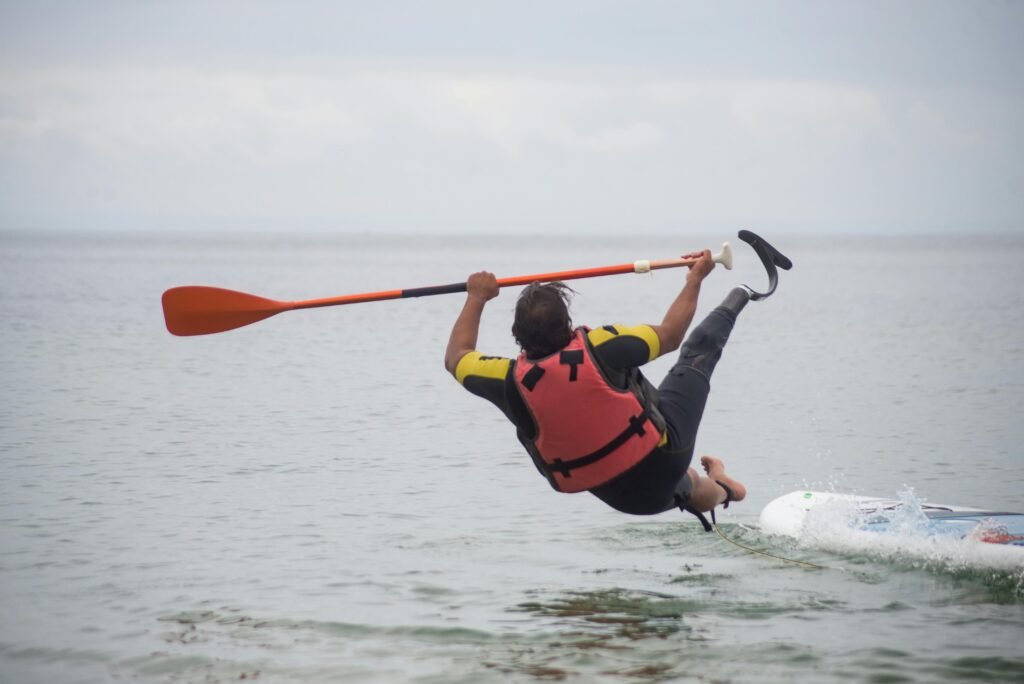Kayaking is an incredibly rewarding outdoor activity that allows you to get out on the water, enjoy nature, and get some exercise all at the same time.
However, for beginners, there are quite a few potential pitfalls and mistakes that can really put a damper on your kayaking experience if you’re not properly prepared.
As someone who has been an avid kayaker for over 20 years, I’ve seen my fair share of beginners make some classic blunders.
But don’t worry, with some guidance, it’s easy to avoid these common mistakes so you can stay safe and have an amazing time on the water. Let’s dive into the biggest mistakes beginners tend to make when starting kayaking.
1. Not Wearing a Proper Kayak Life Jacket
This is by far the most dangerous and potentially life-threatening mistake a new kayaker can make. I can’t stress enough how important it is to always, always, always wear a U.S. Coast Guard approved life jacket or personal flotation device (PFD) when you’re out on the water, even if you know how to swim.
Falling out of a kayak happens more often than you’d think, especially for beginners still getting used to balancing and maneuvering the craft.
If you fall in without a life jacket, the risk of injury or drowning skyrockets, even in relatively calm conditions. Simply put, a life jacket can save your life, so never kayak without one.
Make sure it fits snugly and is in good condition. And wear it at all times when on the water – don’t just stash it under your seat.
In addition to wearing a life jacket, it’s crucial to bring along all essential gear for kayaking. This includes not only your life jacket but also other safety equipment and appropriate clothing to ensure a safe and enjoyable experience on the water.
2. Improper Clothing and Lack of Essential Kayak Safety Gear
Along with a life jacket, you need to dress appropriately for kayaking and the weather/water conditions. The big thing to remember is to dress for the water temperature, not the air temperature.
If you fall in and are wearing improper clothing like cotton fabrics, you can quickly become dangerously cold and lose the ability to swim or get back in your kayak.
Dress in quick-drying, moisture-wicking fabrics and always bring an extra set of warm, dry clothes stored in a waterproof dry bag. A wetsuit or drysuit may be needed if kayaking in very cold water temperatures below 60°F.
It’s also advisable to avoid wearing flip flops due to their lack of support and security in the water, recommending water shoes or secure sandals instead.
You’ll also want to bring a few key pieces of safety gear:
Whistle to signal for help if needed (many areas require you to have an audible signaling device by law)
Bright light or flares if paddling at night or in low visibility
First aid kit stored in a dry bag
Bilge pump or sponge to remove any water that gets in your kayak
By wearing a properly fitted life jacket and dressing for immersion, you’ll be prepared for the unexpected and significantly increase your chances of survival if you do end up in the water.
Don’t underestimate the importance of these basic safety precautions – they could literally save your life.
3. Not Understanding Weight Distribution and Balance

Kayaking can be a thrilling experience, but for beginners, it often comes with a surprising challenge – the feeling of instability and tippiness when getting in and seating properly.
This sensation is due to the kayak’s design with a narrow profile and minimal surface area in the water, aimed at reducing drag.
While this design allows for great manoeuvrability and swiftness, it also means the center of gravity is relatively high, requiring good balancing conditions and proper weight distribution.
Adjusting the seat and footpegs is crucial for a comfortable and controlled paddling experience in a sit in kayak, ensuring stability and safety.
Practicing these adjustments and entering or exiting the kayak in shallow water is ideal for beginners to minimize the risk of tipping over, providing a safer environment to learn and enhance their skills.
Keeping Your Center of Mass Low
The key to maintaining stability in a kayak is to keep your center of mass low and over the centerline or keel. When getting into the kayak for the first time from a dock or shore, it’s advisable to follow these steps:
Keep one foot in the kayak and one on the ground.
Slide your body into the seat relatively quickly but smoothly.
Avoid stepping over the centerline, as this will drastically shift the weight distribution.
Make your movements slow and controlled, shifting your weight distribution minimally until you get a feel for how little movement is required to make the kayak feel tippy.
Proper Posture and Contact Points
Once seated, use your hips and core to stay centered and balanced with good posture. Avoid relying on your arms or upper body for balance. Here are some crucial points to remember:
Lock your thighs and butt under the thigh braces for bracing and control.
Keep your feet firmly on the foot pegs or bulkhead to help maintain a centered position and control.
Try to avoid sudden, jerky movements, as they can cause excessive weight transfer.
Maintain three points of contact at all times: your butt on the seat, your feet on the pegs, and at least one hand on the paddle or bracing against the kayak.
While success in avoiding tipping over involves proper weight distribution and, for beginners, attempts to understand the concept of balance and how it is done, it is of utmost importance that one ensures they maintain the three points of contact at any one time.
By following these guidelines, beginners can improve their stability and confidence in a kayak, making the experience more enjoyable and safe. Don’t skip this over, this will prevent many kayaking blunders and mistakes in the future!
4. Not Understanding Wind, Tides, and Current
Failing to account for the forces of wind, tides, and current is one of the biggest environmental factors that catches beginners off guard and can quickly put you in a precarious situation.
Even a mild 5-10 mph breeze can make it extremely difficult to make headway paddling directly into the wind, quickly sapping your energy.
Tides and currents can also sweep you off course and push you into areas you didn’t intend to go. And winds tend to increase later in the day, so a nice calm morning can turn blustery by afternoon.
Before any paddle, always check the forecasted wind speeds/direction, tide charts, and water current flows. Consider those conditions when planning your route and be ready to adjust accordingly.
For example, paddling with the current or downwind is relatively easy, but trying to paddle upwind, upstream, or against the tide can be brutally difficult and physically draining, especially for beginners.
If winds or currents start to make things too challenging and put you at risk, don’t try to push through it – either head to the nearest shore and wait it out or turn around entirely.
The water will still be there another day when conditions improve. Additionally, beginners should avoid busy waterways where the combination of wind, tides, and currents with heavy boat traffic can increase the difficulty and danger.
5. Lack of Knowledge and Planning
Thorough planning and preparation are crucial for a successful and safe kayak outing. Speaking of which, one of the major rookie kayaking mistakes is heading out onto the water without properly researching the area and planning your route ahead of time.
Just winging it and not knowing what potential hazards or obstacles you may encounter is a recipe for getting yourself into a sticky situation you may not be prepared for.
For any body of water you’ll be kayaking on, make sure to look into relevant information like:
Depth levels
Underwater hazards (rocks, stumps)
Areas with heavy boat traffic to avoid
Any closed zones or restrictions
Potential risks (high winds, currents in certain areas)
Maximum distances to paddle for your skill level
Locations of access points to launch and take out
Emergency contacts for that area should you need rescue assistance
It’s also very wise to let others know your planned route and what time to expect you back.
You should also do research on:
The type of wildlife in the area
To avoid potentially dangerous animals (aggressive swans, territorial species)
To scout for opportunities to view wildlife (if of interest)
Relevant local regulations or permitting requirements for the areas you’ll be paddling in.
Proper PlanningWinging ItSafer outingPotential perilEnjoyable experienceUnpleasant surprisesAmazing sightsMissed opportunities
The bottom line is failing to plan ahead and do your research means you could very well miss out on some amazing sights and experiences, or put yourself into peril because you came across something unexpected that you weren’t prepared to safely handle.
With a bit of planning and knowledge ahead of time, you’ll have a much safer and more enjoyable outing while avoiding unpleasant surprises.
6. Poor Kayak Paddle Strokes Technique and Lack of Skill Practice

Proper paddling technique is absolutely critical for controlling and maneuvering your kayak efficiently and avoiding muscle strain or injury.
Yet beginners often develop poor form and bad habits right from the start that can be difficult to correct later on – these are common kayaking mistakes that should be avoided.
Developing good technique requires consistent practice over time, focusing on:
Keeping your spine straight and twisting from the hip when turning, rather than just using your arms
Torso rotation and body positioning for powerful yet low-effort strokes
Maintaining a high-angle paddling position
Understanding fundamental strokes like draws, sweeps, and braces
Mastering different types of paddle strokes, including the forward stroke, which is the most frequently used stroke and essential for moving the kayak forward, and the sweep stroke, a basic turning stroke in kayaking.
It’s also crucial to know the type of paddle blades you have and how to use them effectively, ensuring the paddle blade is oriented correctly in the water.
Proper grip and hand positioning on the paddle shaft are key for efficient paddling and maneuvering.
Simply heading out a couple of times a season isn’t going to cut it. You need to spend time on the water frequently while actively thinking about and tweaking your paddling form.
Consider taking lessons from a certified instructor or guide service to learn proper techniques from the start. Alternatively, watch tutorial videos and practice the strokes and skills on a local pond or slow river.
You’ll also want to practice maneuvers like:
Turning your kayak from a stationary position
Draw strokes to move sideways
Proper forward strokes
Low braces
Wet exits and re-entries until these skills become second nature
Failing to have these essential skills dialed can quickly turn a minor inconvenience into a potentially life-threatening situation should you ever actually need to wet exit.
7. Lack of Fitness and Improper Boat
Many beginners overestimate their physical ability and stamina when it comes to kayaking, or fail to prepare properly.
Not having adequate fitness or the wrong kayak for your needs are common kayaking mistakes that can really diminish your experience and potentially put you at risk.
While kayaking itself is relatively low impact, the repeated paddling combined with maintaining proper, engaged body positioning requires a base level of:
Core strength
Flexibility
Cardiovascular fitness
Without these, fatigue and sloppy form set in quickly, dramatically increasing your chances of making dangerous kayaking mistakes like taking an unexpected swim.
It’s wise to work on building up your core, back, shoulder strength, flexibility, hip mobility, and grip strength through exercise before taking up kayaking. Getting in cardiovascular shape will also allow you to paddle for longer durations without gassing out.
In addition to being in reasonable physical shape, you need to make sure you have the right kayak for the type of paddling and environments you’ll primarily be in. T
he kayak design, materials, and features required for a short recreational flat water paddle are quite different from those needed for all-day ocean touring, whitewater rapids, fishing, surfing, racing, etc.
Don’t just buy the first kayak you see or the cheapest option. Do your research and be honest about your intended uses, skill level, weight limits, storage/transportation needs, etc. The wrong boat can negatively impact your performance, comfort, safety, and overall enjoyment.
It’s usually better to start with a more stable, wider recreational kayak while you build experience before moving to a narrower touring or sea kayak down the road.
And unless you have the ability to test out several options, consider buying a quality used kayak from a reputable seller at first.
That way, you can get a feel for what you like or don’t like without breaking the bank. Then, once you have more experience under your belt, you can invest in a new kayak ideally suited to your preferences.
8. Poor Safety Practices
While kayaking is generally a very safe activity when done responsibly, there are some critical safety practices beginners commonly overlook that can quickly escalate a minor issue into a life-threatening emergency if you’re not prepared.
It’s advisable for beginners to start their kayaking experience in calm water to ensure safety and build confidence, avoiding conditions that are beyond their skill level, including rough waters.
Never Kayak Alone
First and foremost, never, ever kayak alone, especially as a beginner. Having at least one other person (and preferably more) provides a much-needed safety net should anything go wrong. If you capsize and are alone, you may have extreme difficulty getting back into or righting your kayak, especially in colder waters.
Hypothermia can set in shockingly fast, making self-rescue nearly impossible. A simple slip and fall reboarding your kayak solo could result in a serious injury, leaving you stranded on the water. By having a partner, they can assist with rescues and provide help should any emergency occur.
Communication and Emergency Preparedness
Always let others know your planned route and what time you expect to be back.
Have a system for calling for help if needed – a whistle or emergency communication device like a VHF radio or satellite messenger.
Avoid becoming a tragic headline by taking these basic precautions.
Dress for Immersion and Be Prepared to Get Wet
Always dress for the possibility of an immersion and be prepared to get wet.
Dress for the water temperature with moisture-wicking fabrics.
Avoid any clothing that gets heavy when waterlogged, as it makes swimming and self-rescue exponentially harder.
Always have a means to get yourself back into your kayak from the water, or at minimum a way to hang onto your kayak and paddle/float to safety.
Practice bracing for your kayak type and master the techniques for righting and draining a swamped kayak.
Know Your Limits
It’s important to be aware of your personal limits and comfort levels. Don’t let yourself get peer pressured into pushing beyond what you’re capable of or putting yourself into situations that make you uncomfortable from a safety standpoint.
A good rule of thumb is to only attempt things you’re 90-100% confident you can safely handle.
There’s no shame in turning back or avoiding areas that exceed your skill level – not being able to self-rescue from rough, cold waters is a perfectly valid reason to avoid it entirely until your experience grows. Good judgment ultimately reduces risks and keeps you kayaking another day. Being stubborn or foolishly overconfident is how kayakers get themselves killed and make critical kayaking mistakes.
9. Lack of Etiquette and Environmental Stewardship
Finally, while not directly related to safety, two other big mistakes beginners often make come down to not respecting proper kayaking etiquette and being poor environmental stewards by not following Leave No Trace principles.
Kayaking Etiquette
Be aware that you’re not alone out on the water and there are right-of-way “rules of the road” to follow to maintain safety and order, just like driving:
Paddlecraft like kayaks, canoes, and sailboats typically have right of way over larger motorized vessels that create bigger wakes.
Stay out of shipping channels or high-traffic areas for your own safety.
Be mindful of fishing lines and avoid cutting across or crowding anglers.
If you see someone struggling or in need of help, stop to assist or call for help if needed.
Environmental Stewardship
It’s critical that you leave any outdoor area you paddle in better than you found it. Follow Leave No Trace principles religiously:
Pack out every single piece of trash, leftovers, and waste you bring – and be prepared to pick up any litter you may come across as well.
Secure all items so nothing can blow or fall overboard from your kayak.
Be respectful of wildlife by maintaining a healthy distance and never harassing or feeding animals.
Choose an environmentally-friendly kayak design with minimal draft/wake to avoid disrupting the underwater ecosystem.
Use designated launch points and avoid traversing shorelines in sensitive areas to prevent erosion.
Apply eco-friendly sunscreen and insect repellents to limit chemical contamination.
Follow all local regulations and area restrictions in place to protect fragile environments.

Avoid making too much noise that could disturb other visitors trying to enjoy nature’s peace and solitude. Keep voices down and don’t blast music that could carry long distances over water. Be courteous of private property boundaries and don’t trespass where you don’t have permission.
By following basic environmental and social etiquette, you help preserve these amazing natural spaces for everyone to responsibly enjoy while not creating negative impacts that could ultimately restrict kayakers’ access or harm the areas we all love to paddle in.
Conclusion
Kayaking is an incredibly fun and rewarding activity, but it does take some precautions, preparation, and practice to do it properly and avoid the most common mistakes. By prioritizing safety, developing good fundamental skills, and respecting the environment and etiquette, you’ll avoid easily preventable yet potentially disastrous scenarios and ensure an enjoyable experience immersed in nature with a new rewarding hobby you’ll treasure for life.
Start small, start smart, and don’t be afraid to keep learning through instruction, experience, and from your own mistakes when they inevitably happen. Be safe, be smart, and just keep paddling!

